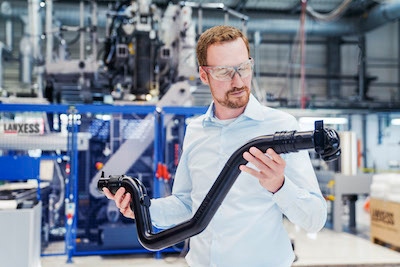From Germany’s Lanxess, the material is durable up to 230°C and targets usage in compact internal combustion engines in hybrid vehicles.
October 17, 2019

According to studies conducted by German materials supplier Lanxess, around 80 percent of newly registered vehicles in 2035 will still have an internal combustion engine – in the form of either a mild-hybrid engine, plug-in hybrid engine or pure combustion engine. The trend will shift toward turbocharged engines because they are more efficient and more eco-friendly.
|
Charge air duct in smaller engines must be capable of withstanding increasingly higher temperatures due to the smaller installation spaces, rising engine power and new engine designs. |
The charge air duct in these engines must be capable of withstanding increasingly higher temperatures due to the smaller installation spaces, rising engine power and new engine designs. This is why Lanxess has developed Durethan AKV320ZXTS2 (currently available as Durethan TP202-048), a blow-moldable polyamide (PA) 66 that, due to its thermal durability of up to 230°C, is capable of meeting high temperature requirements. The abbreviation XTS stands for “Extreme Temperature Stabilization”. At K 2019, the High Performance Materials business unit will be showcasing this innovative compound.
The new compound is a further development of the recently launched Durethan AKV320ZH2.0 and also has a wide processing window for suction blow molding. It is also resistant to pressure changes at high temperatures and produces smooth pipe surfaces with an extremely high-quality surface finish. “Our material does not exhibit any stabilization gaps between 160°C and 230°C and still delivers outstanding mechanical performance even at 230°C,” says Dr. Klaus Küsters, who is responsible for the business development of blow molding at Lanxess.
HPM has extensively investigated the thermal resistance of the new structural material which is toughness-modified and reinforced with 20 percent glass fiber. One typical test is storing the material at different temperatures in hot air. Even after ageing for 3,000 hours at 230°C, its strain at break is still greater than 2 percent. Therefore, it is the material of choice with engine designs in which charge air cooling is integrated in the air intake manifold. This results in an extremely compact design and, in turn, a high thermal load on the air-ducting parts.
Like Durethan AKV320ZH2.0, the new PA 66 compound has been optimized for a stable production process in a 3D suction blow-molding process. Küsters: “Thanks to its high melt stiffness, the wall thickness of the components can be controlled with an extremely high degree of reproducibility.” Optimizing the material for the suction blow molding process also means that the surface is of high quality even when the parison comes into contact with the cool tool during processing.
About the Author(s)
You May Also Like





